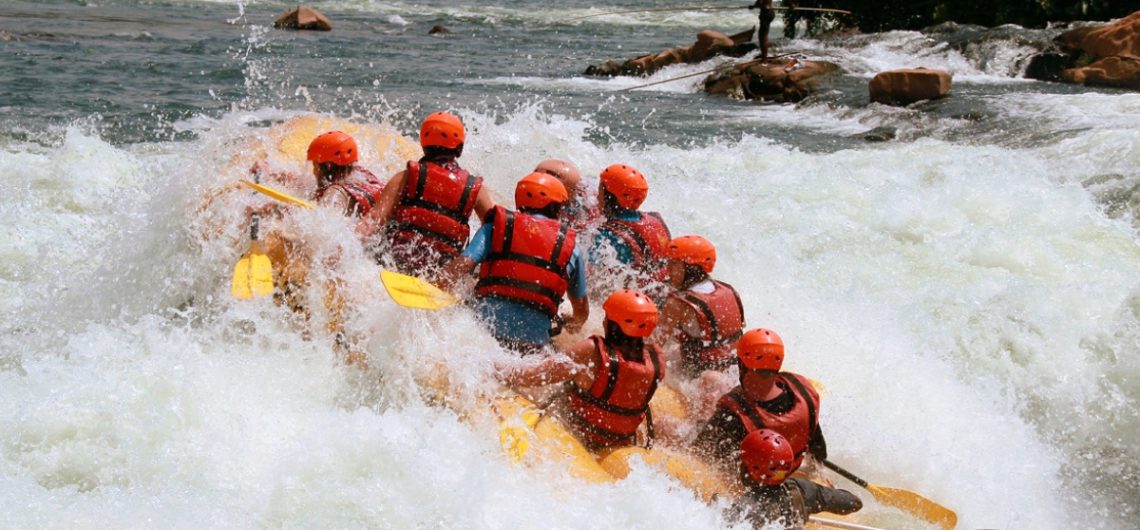White Water Rafting in Jinja
Whitewater rafting in Uganda provides an unforgettable experience along the Nile and at Jinja. Jinja was a modest fishing town on the Nile’s banks before John Hannington Speak discovered its source and the entrance of British colonialists. When Uganda became a British colony, the fishing community expanded into a big commerce center, with the Nile River serving as an important crossing point to the country’s eastern region all the way to Kenya. The town expanded as more Europeans, Indians, and Ugandans migrated there.
Jinja soon became Uganda’s most industrialized town once the railway and hydroelectric power were installed. However, the volatile Idi Amin dictatorship between 1972 and 1979 led Jinja to lose its role as Uganda’s industrial powerhouse. When Idi Amin evicted all Asians from Uganda, the industries were deprived of the necessary knowledge. Even after the Asians returned, Jinja’s status was never regained. Kampala has now surpassed it as Uganda’s industrial center. But all was not lost since, despite losing its industrial standing, tourism prospered. Jinja, and Uganda in general, is a wonderful destination to explore the splendor of Africa. Apart from the tranquility of the town, travelers are drawn to Jinja by the Nile and Lake Victoria. After exploring Uganda’s national parks, the calm town is ideal for leisure and recuperation.
The Nile River provides some of the most adrenaline-pumping sports on the planet, including bungee jumping, quad biking, horseback riding, and whitewater rafting, the focus of this article. Whitewater rafting is a fantastic sport that teaches you how to be cool under pressure. The opportunity to experience whitewater rafting on the world’s longest river is incredible. It is one of the most enjoyable things to do in Uganda. Several civilizations have relied on the Nile for water.
Whitewater rafting in Jinja takes you through wild and furious rapids in the heart of the Nile. The Nile rapids at Jinja are classed 4 and 5 and provide some of the best whitewater rafting in Africa. The rapids are larger and more powerful than those on the Zambezi. Despite the fact that the recent building of the Bujagali and Isimba dams has resulted in the destruction of several of the Grade five rapids such as Namizi, The Bad Place, and Kyabirwa, whitewater rafting remains a viable option. Rafting businesses have had to alter and change their launching place and overall route further downstream while still providing the same adrenaline rush and gorgeous landscape.
What to expect during whitewater rafting in Jinja
A day of whitewater rafting begins with an early morning meal before being taken to the river’s banks. All participants must leave valuables and dry clothes in the car with staff. The teams are instructed on safety and what to expect. The introduction is overseen by guides who are quite informed about the region and rapids. They go through every area of safety to ensure that all rafters have the greatest experience possible. Other subjects discussed include how to grab the rope for safety, how to paddle, and how to properly exit the raft. If participants trip while holding their breath, they are instructed to stay as cool as possible. Always bring extra underwear and dry clothing when traveling. Choose clothing that dry quickly because you will be in and out of the water frequently.
Individuals are given the option of taking an easy or challenging path before the activity begins. Those who are not prepared for Grade 4 and 5 rafting might choose Grade 3 rafting. Families can choose a calmer family float excursion that allows them to appreciate the river while avoiding the big rapids. All participants must sign a paper detailing any medical conditions. You cannot go rafting if you have hypertension or anemia. The activity can begin once the orientation is completed and the helmets and rain coats are attached. The first mile or two allows the guides to adequately prepare all participants before the rapids get stronger and more magnificent downstream.
When you approach the next rapid, the guides organize for a vote on whether to take the simple path (edges) or the difficult route (middle). If the majority chooses the difficult path, there is little you can do but prepare for the challenge. The experienced rafters are escorted to the most dangerous portion of the currents and allowed to tip over. If the team leader is leading a group of novice people, he or she will approach each rapid at the weakest/easiest point so that they do not trip. If the novice party comes upon a major rapid, they exit their rafts and walk around it. Each rapid provides a unique experience that is largely dependent on how the lead guide navigates.
The main route has nine major rapids, four of which are grade 5. As you travel downstream, the rapids get stronger and faster. In between the rapids, there are calm waterways and islands where participants may rest, swim, have lunch, and take in the breathtaking view. A full day of whitewater rafting may cover up to 26 kilometers. Expect to see folks fishing and drying their clothes by the river. The Jinja River is a birder’s dream, with over 100 species. Perceptive watchers may even detect vervet monkeys dangling from the branches of trees along the riverbank. Following the exercise, a small party is held at which participants are given free beverages and transportation back to the lodge.


Comments